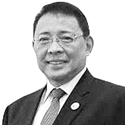Fighting dinosaurs with technology

Signs And Wonders
Diwa C. Guinigundo

Corruption is like dinosaurs. Dinosaurs varied in size — they could be incredibly huge, the biggest seemed to be the Argentinosaurus which was placed at about 40 meters in length, weighing 100 metric tons, or relatively small like the Microraptor, approximating the size of a crow.
Corruption could likewise be so pervasively large it goes from the top to the bottom of bureaucracy, a syndicated enterprise that enables a small, undercapitalized company like Starpay, for instance, to handle the distribution of P50 billion in cash assistance to impoverished families. We should be familiar with another dinosaur of big corruption that is Pharmally, another small company that supplied billions of pesos worth of personal protective gear to the government found to be defective and expired. Like dinosaurs, corruption has to feed on an enormous amount of vegetation or meat to survive.
Microraptor corruption involves overpricing of office supplies and other commonly consumed items. Fixers and their “connect” in car registration or building permits in city hall are like crows, but adult crows.
Today, civil societies are now pushing back at corruption regardless of its scale. It should be extinct in due time.
There is no other way to deal with corruption but to stop it. Its social cost has been impossibly enormous. The IMF’s Finance and Development of March 2018 cited a figure of as much as $2 trillion a year, estimated to be as large as Italy’s gross output and many times over the $142 billion in international development aid. The Conversation updated it to $2.6 trillion in May 2021.
The literature also posits that corruption discourages private investment which restricts economic growth. An earlier IMF study, for instance, “Corruption: Costs and Mitigating Strategies” argued that “Corrupt officials channel public funds to wasteful projects that generate bribes, depleting funds that could be spent on health, education, and other services that benefit the poor…”
Susan Rose-Ackerman of Yale University also established the link between corruption and growth: “Countries that are less corrupt have higher growth rates, have higher levels of GDP, and have higher levels on the Human Development Index of the United Nations.”
Just like the obsolete dinosaurs, corruption should disappear because in the new economy of greater transparency, accountability, and strong institutions — corrupt practices and betrayal of public trust are not exactly in synch with the liberating impact of modern technology.
Both the IMF and the World Bank institutionalize their concerns about corruption in their country reports and consultations. It is imperative that principles of transparency and accountability characterize governance across the whole range of membership of these global bodies.
Now driving the momentum to bring the fight against corrupt practices in the public sector to a higher pitch are innovations in new technology that have become widely accessible. They are extremely promising.
For example, private technology company Bitfury Group is ministering to the needs of the Republic of Georgia for a system of land registration using blockchain technology. Blockchain technology offers a database system that automatically records transactions as well as an exchange system for both money and information. This is anti-corruption because records are encrypted and warehoused in computers in different locations so they cannot be altered or stolen. Records are permanently available. There are no folders to squirrel away, or disks to copy and erase.
The Fund also noted the contribution of Dublin-based AID:Tech that developed a platform for both charitable institutions that solicit and distribute charitable contributions, and government departments that receive taxpayers’ money and dispense it for social welfare. This could be very useful to our own Department of Social Welfare Development for their periodic disbursement of cash transfers. The idea is to ensure the integrity of both receipt and disbursement of donated funds and public money.
Another possible use for blockchain is securing digital storage of documents. Signatura, a blockchain-based platform for signing and notarizing documents among multiple people, turned out extremely useful in validating financial disclosures of public officials. Forms are made visible to the public and cannot be altered. A procurement platform has also been devised called Teneris that can be used by both firms and governments to solicit bids from potential suppliers, and which could discourage bribery and bid rigging.
With all these public goods of innovative technology, the Fund launched the Anti-Corruption Challenge during the 2019 World Bank-IMF Annual Meetings. This initiative aims to support the development of new and innovative approaches to effect behavioral change and increase transparency against poor governance and corruption. The Fund’s initiative received sponsorship from the Swiss State Secretariat for Economic Affairs with MIT-IBM Watson AI Lab as technical partner. Seed funding was extended to the qualifying entries.
After two years and 100 proposals from 30 countries, during this year’s Annual Meetings, the outcome was very impressive. Four winners were announced in the second segment of the “New Economy Forum: Fighting Corruption with Technology.”
The winning proposals demonstrate that technology has truly come of age in fighting corruption and improving governance. Today’s pandemic challenge has made it even clearer that technology could be pandemic-proof, and very potent against bad governance. Big data, data mining, blockchain, and other digital innovations could help achieve greater transparency and accountability, and avoid corruption.
Which were the winning proposals?
Team 1: “Joining the Dots with Public Officials: Cross-Matching Beneficial Ownership and Financial Disclosure Data to Identify Red Flags.”
Team 2: “Public Procurement Corruption Risks: Harnessing Big Data for Better Fiscal Governance and Growth.”
Team 3: “Optimizing the Detection of Beneficial Ownership of High-Risk Firms in Brazil”
Team 4: “Enhancing Transparency in Wage Bill Practices: Leveraging Blockchain”
Team 1’s output could be very useful in piercing through corporate veils to establish beneficial ownership with the red flags from public officials’ financial disclosures. In the Philippines, through open data source, data analytics, and machine learning technology, it might be possible to see whether the declared Statement of Assets, Liabilities, and Net Worth (SALN) of public officials are consistent with their corporate exposure through beneficial ownership.
Team 2 recognized that government data are fragmented and available only in silos. Through big data technology, data granularization might be possible by government entity, by specific contract, and by individual contractor. Real-time tracking of a corruption index will help establish the identity of possible favored cronies and pricing in procurement. This is expected to lead to better policy scenarios and reduction of the cost of corruption. With something like this in various government departments involved in infra projects, we should be seeing less roads that lead to nowhere, and more durable avenues and bridges serving municipalities and barangays regardless of political parties.
Team 3 was contextualized in Brazil and aimed at creating a solid and actionable tool for automating and optimizing the identification of potential beneficial owners of high-risk firms in Brazil. We have many of these in the Philippines. With great amount of open data source, the Team suggested the use of data science and operational research tools to integrate large data sets, developing algorithms and creating decision support systems.
Team 4 presented the project aimed at assisting public administration and finance in small economies to reduce corrupt wage bill practices by deploying blockchain solutions. Key product capabilities could be identified, user stories could be developed. Blockchain technology creates a permanent trail of transactions to establish the complete traceability of every transaction by verifying identity, registering assets, and tracking transactions, functionalities that are critical in combatting illicit trades and money laundering.
Technology can therefore be empowering and a possible safeguard against impunity. Without any safeguard, as Nobel Laureate Rigoberta Menchu Tum correctly pointed out, “impunity becomes the very foundation upon which systems of corruption are built.” To achieve the ultimate end of defeating corruption, people should be assured that there are ways of changing such a withering system.
Using technology is definitely one of them.
Diwa C. Guinigundo is the former deputy governor for the Monetary and Economics Sector, the Bangko Sentral ng Pilipinas (BSP). He served the BSP for 41 years. In 2001-2003, he was alternate executive director at the International Monetary Fund in Washington, DC. He is the senior pastor of the Fullness of Christ International Ministries in Mandaluyong.
